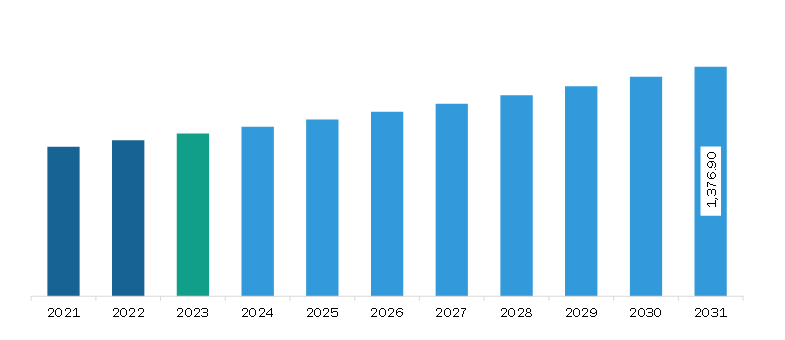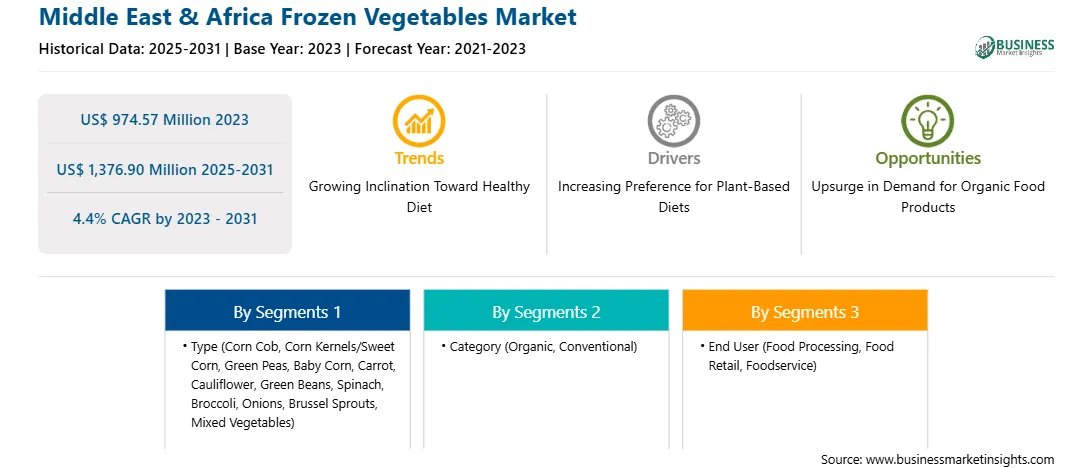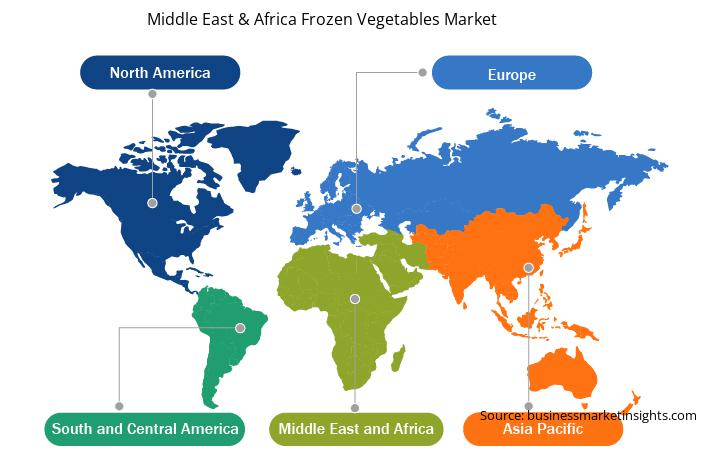The Middle East & Africa frozen vegetables market was valued at US$ 974.57 million in 2023 and is expected to reach US$ 1,376.90 million by 2031; it is estimated to register a CAGR of 4.4% from 2023 to 2031.
Sustainability in the Frozen Vegetable Industry Bolsters Middle East & Africa Frozen Vegetables Market
Sustainability is becoming a core focus in the frozen vegetable market, driven by both consumer demand and environmental responsibility. One major advantage of frozen vegetables is reduced food waste—thanks to their long shelf life, they help limit spoilage at both retail and household levels. Additionally, many producers are transitioning to eco-friendly packaging, such as recyclable or compostable materials, to minimize plastic waste.
Sustainable farming practices are also gaining traction, including reduced pesticide use, crop rotation, and organic certification. Locally sourced produce is being prioritized to lower carbon emissions from transportation. Energy-efficient freezing and storage technologies are being adopted to further reduce environmental impact.
Moreover, companies are increasingly transparent about their sustainability efforts, using labeling and certifications to inform eco-conscious consumers. As sustainability becomes a key differentiator, brands that invest in green innovations are better positioned to lead the market in the coming years.
Middle East & Africa Frozen Vegetables Market Overview
In the Middle East and Africa, the middle-class population is increasing, along with rising disposable income. With improved purchasing power, consumers are more inclined to explore a variety of frozen vegetables, including premium and exotic options. The presence of supermarket chains and the development of cold chain infrastructure in countries across the Middle East further facilitate the availability and accessibility of frozen vegetables. The market also witnesses growing production and consumption of organic produce in a few countries, such as Saudi Arabia, Kuwait, and the UAE. According to Business Start Up Saudi Arabia, the number of organic farms increased by 28% in 2021 owing to Saudi Arabia's US$ 200 million strategy for innovation plan. The plan aims to increase the capacity of organic farming by 300% in the coming years. The rising urbanization, increasing disposable income, and advancement in supply chain infrastructure are a few factors that drive the market for frozen vegetables.
Strategic insights for the Middle East & Africa Frozen Vegetables provides data-driven analysis of the industry landscape, including current trends, key players, and regional nuances. These insights offer actionable recommendations, enabling readers to differentiate themselves from competitors by identifying untapped segments or developing unique value propositions. Leveraging data analytics, these insights help industry players anticipate the market shifts, whether investors, manufacturers, or other stakeholders. A future-oriented perspective is essential, helping stakeholders anticipate market shifts and position themselves for long-term success in this dynamic region. Ultimately, effective strategic insights empower readers to make informed decisions that drive profitability and achieve their business objectives within the market. The geographic scope of the Middle East & Africa Frozen Vegetables refers to the specific areas in which a business operates and competes. Understanding local distinctions, such as diverse consumer preferences (e.g., demand for specific plug types or battery backup durations), varying economic conditions, and regulatory environments, is crucial for tailoring strategies to specific markets. Businesses can expand their reach by identifying underserved areas or adapting their offerings to meet local demands. A clear market focus allows for more effective resource allocation, targeted marketing campaigns, and better positioning against local competitors, ultimately driving growth in those targeted areas.Middle East & Africa Frozen Vegetables Market Revenue and Forecast to 2031 (US$ Million)

Middle East & Africa Frozen Vegetables Strategic Insights

Middle East & Africa Frozen Vegetables Report Scope
Report Attribute
Details
Market size in 2023
US$ 974.57 Million
Market Size by 2031
US$ 1,376.90 Million
CAGR (2023 - 2031) 4.4%
Historical Data
2021-2023
Forecast period
2025-2031
Segments Covered
By Type
By Category
By End User
Regions and Countries Covered
Middle East & Africa
Market leaders and key company profiles
Middle East & Africa Frozen Vegetables Regional Insights

Middle East & Africa Frozen Vegetables Market Segmentation
The Middle East & Africa frozen vegetables market is categorized into type, category, end user, and country.
By type, the Middle East & Africa frozen vegetables market is segmented into corn cob, corn kernels/sweet corn, green peas, baby corn, carrot, cauliflower, green beans, spinach, broccoli, onions, brussel sprouts, mixed vegetables, and others. The others segment held the largest share of the Middle East & Africa frozen vegetables market share in 2023.
In terms of category, the Middle East & Africa frozen vegetables market is bifurcated into organic and conventional. The conventional segment held a larger share of the Middle East & Africa frozen vegetables market share in 2023.
Based on end user, the Middle East & Africa frozen vegetables market is segmented into food processing, food retail, and foodservice. The food retail segment held the largest share of the Middle East & Africa frozen vegetables market share in 2023.
Based on country, the Middle East & Africa frozen vegetables market is segmented into South Africa, Saudi Arabia, the UAE, and the Rest of Middle East and Africa. The Rest of Middle East and Africa segment held the largest share of Middle East & Africa frozen vegetables market in 2023.
Alasko Food Inc.; Ardo Foods NV; B&G Foods; Bonduelle SA; Dawtona Frozen; General Mills Inc; Goya Foods Inc; Grupo Virto; Hanover Foods; La Fe Foods; McCain Foods Ltd; Mondial Foods BV; Mother Dairy Fruit & Vegetable Pvt. Ltd; Seneca Foods Corp; and Simplot Global Food are some of the leading companies operating in the Middle East & Africa frozen vegetables market.
The Middle East & Africa Frozen Vegetables Market is valued at US$ 974.57 Million in 2023, it is projected to reach US$ 1,376.90 Million by 2031.
As per our report Middle East & Africa Frozen Vegetables Market, the market size is valued at US$ 974.57 Million in 2023, projecting it to reach US$ 1,376.90 Million by 2031. This translates to a CAGR of approximately 4.4% during the forecast period.
The Middle East & Africa Frozen Vegetables Market report typically cover these key segments-
The historic period, base year, and forecast period can vary slightly depending on the specific market research report. However, for the Middle East & Africa Frozen Vegetables Market report:
The Middle East & Africa Frozen Vegetables Market is populated by several key players, each contributing to its growth and innovation. Some of the major players include:
The Middle East & Africa Frozen Vegetables Market report is valuable for diverse stakeholders, including:
Essentially, anyone involved in or considering involvement in the Middle East & Africa Frozen Vegetables Market value chain can benefit from the information contained in a comprehensive market report.